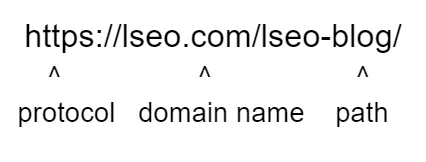When we talk about the best practices of SEO, we have to mention the URL structure of a page. Among the 200+ Google ranking factors that we know about, URL structure is usually considered a minor one. But if something can be optimized to help a page rank better, we do it, and that’s why we’re talking about the importance of URL structure for SEO today.
Let’s play a little game first before we start digging into this. To test your knowledge of SEO-optimized URL structures, take the quiz below before reading this post, and see how you do.
Based on how many questions you get right and wrong, you may realize there’s more to an SEO page optimization than you thought, and your website could use better URLs and a whole range of other SEO fixes.
If that’s the case, LSEO can help! Just tell us what you need, and we will find the solution for you.
Here’s the quiz. We hope you enjoy it and learn a little something. After that, you’ll find our explanation of how URL optimization works!
Why Do URLs Even Matter?
Let’s start at the very beginning to set the stage. Forget about optimizing URLs for SEO for now. Why do URLs even matter at all?
“URL” stands for “Uniform Resource Locator,” which is a technical term for a web address. URLs tell web browsers where to go to find the information you’re looking for.
In the same way that a person or organization has a street address, a URL is the address of a web page. Without a URL, no one would be able to find a web page they want.
The various parts of a URL provide specific information about where a resource is located. The main components of a basic URL are protocol, domain name, and path.
Take this example:

The protocol is also called the scheme, and it controls how browsers and servers talk to each other when you access the resource. HTTP, which stands for Hypertext Transfer Protocol, is a common protocol, but it isn’t a secure way to communicate on the Internet.
You need HTTPS for that, which refers to Hypertext Transfer Protocol Secure. That just means a browser is going to encrypt the information you input on a web page, such as your login credentials or credit card. HTTPS is the better of the two protocols today because it means a website is secure.
Then, there’s the domain name, which is simply the name of your website followed by the top-level domain, or TLD. The TLD is simply the .com, .org, .gov, or .net that completes a URL.
Then we come to a forward slash followed by the path, which is simply the file directory on the server of the website in question. In other words, the path tells the browser what specific page on the website you want to visit.
In the example above, someone would want to go to the secured HTTPS version of the LSEO blog on the LSEO website, simple as that.
Now we know what URLs are for and why they’re structured like they are. But what should be included in the best URL structures for SEO? How does an SEO-optimized URL differ from an unoptimized one?

The Proper URL Structure for SEO
Now, not all websites will have as simple a URL structure as in the example above; some websites have subdomains that show up in the URLs, while others are marked up with UTM codes that complicate things a bit.
Whatever kind of complexities are involved in your URLs, however, there are a number of best practices for laying out your URL structures. If you really want to get down to business on how your website should be organized, check out this post on the elements of a well-designed website, since URL structure should really reflect the site architecture you already have.
The good news, though, is that it’s actually pretty simple and straightforward to optimize your URLs for SEO. The best practices are common sense, for the most part, and Google has also said explicitly what to do here.
Here are the things to keep in mind.
1.) Organize Your URLs in Easy-to-Understand Ways
This calls back the post I referenced above on well-designed websites. You should set up your URLs in a way that reflects the (ideally) simple structure on your website. A good example would be the following:
https://www.yourexamplewebsite.com/services/example-service-1/
You can see that we go from the domain name to the TLD, and then the category /services/, and ending with the page /example-service-1/.
That keeps things nice and simple. It’s a clean URL structure that shows the website, the category page we’re going to, and then the page within that category.
So that’s the order of the website, and it shows up in the URL structure. It’s important to keep things easy like that because it helps users and Google to understand where these resources are in relation to your overall site.
2.) Use Descriptive Words and Keywords in Your URLs
Someone should be able to tell what a page on your website is about just from looking at the URL. A URL should not look like this:
https://www.yourexamplewebsite.com/pageID=3458576.php?
No one would know what kind of content lies on that web page, and it hurts their chances of clicking on it if they see it in the SERPs or anywhere else.
Instead, you should allow your URLs to describe what a page is about.
Take blog posts, for instance. When a website publishes blog posts, each post will be about a different topic related to the industry of the business. If you want people and search engines to know what can be found in that post, you should have your URL path reflect the post’s title, like this:
https://www.yourexamplewebsite.com/blog/how-to-create-curriculum-for-your-class/
Short and sweet. That’s the blog post title (minus the unnecessary article “a,”) and that’s what you see in the URL.
If you really want to simplify things, you even have the option of not going with a URL structure that has the /service/ or /blog/ category parts in the path. The shorter and easier to understand, the better off you will be.
Fortunately, when you build your website on WordPress, the CMS automatically generates URLs for you based on the titles of your pages and posts, and this is where SEO keywords come in.
The content you publish on your website should be optimized for target keywords if you want to give it a good chance to rank well on Google.
If your URLs always reflect your content titles, then your URLs should contain those SEO keywords, as well. Including keywords in URLs is a good idea because, once again, those words will tell everyone what the page is about.
Keywords in URLs are also a minor ranking factor for Google. They definitely help your rankings a little, but just know that there are other ranking factors that hold much more weight with Google.
3.) Separate Words with Hyphens
The parts of a URL have to be separated from one another while still being strung together to make a whole. That means you can’t use spaces between words in URLs, because the browser won’t count whatever comes after the space.
Underscores are similarly bad practice for separating URL words. That’s because they’re only seen at the bottoms of the letters.
If you were to present that URL as a link to someone, the automatic underlining would hide your underscores, and no one would be able to tell whether those words at the end were supposed to be part of the URL. It would just look bad.
So, we use hyphens as the standard separator between words in a page title.
The top URL here looks much better than the bottom one:
https://www.yourexamplewebsite.com/blog/how-to-create-curriculum-for-your-class/
https://www.yourexamplewebsite.com/blog/how_to_create_curriculum_for_your_class/
4.) Avoid Including Dates in URLs
In SEO content, it’s often a good idea to include dates in the titles of your posts because dates show timely relevance. Users want to know that this list or guide was published in the current year rather than two years ago.
However, while it’s extremely easy to go in and update the date on a post title, changing URLs around complicates things a little, because you’d have to go and redirect an old URL to a new one.

It isn’t a huge deal to do that, but to avoid the problem entirely, you can just exclude dates from your URLs. The URLs should still match the post title otherwise.
You don’t absolutely need to do it that way, though. If you prefer to have dates in your URLs and don’t mind redirecting them to an updated URL every year, then keep doing what you’re doing.
5.) Decide on a Trailing Slash Structure
Lastly, when it comes to devising the right URL structure for SEO, you should decide whether you want your pages and posts to end with trailing slashes or not.
A quick word on trailing slashes: officially, a URL that ends with a trailing slash (/) tells Google that the destination is a category page that contains still further resources. A URL without a trailing slash is meant to be a file, meaning the page is the resource.
That doesn’t matter so much anymore. Google says that your root domain can end with a slash or not, and it will know that it’s the same domain regardless.
It also doesn’t matter which style you choose for your pages and posts, but you have to be consistent across your site. That’s because Google does see pages with and without trailing slashes as different pages.

Google itself has laid out its philosophy on trailing slashes and how they affect your URLs. Basically, if you have two versions of the same page, one with a trailing slash and one without, and they both return 200-level response codes, that’s duplicate content. You’d have to redirect one to the other to eliminate duplication.
Overall, if you want to avoid issues with redirects and duplicate content that arise over something as silly as a trailing slash, just stick with one style consistently on your website.
LSEO Can Help You Create the Best URL Structure for SEO
If you’ve been having problems with URLs that are not optimized for SEO – such as content duplication issues or keywords not being included in your URLs – talk to our experts at LSEO.
We have decades of combined SEO experience and would be happy to audit your site to correct those little nagging issues that are holding you back from ranking where you want.
Get in touch with us today!
